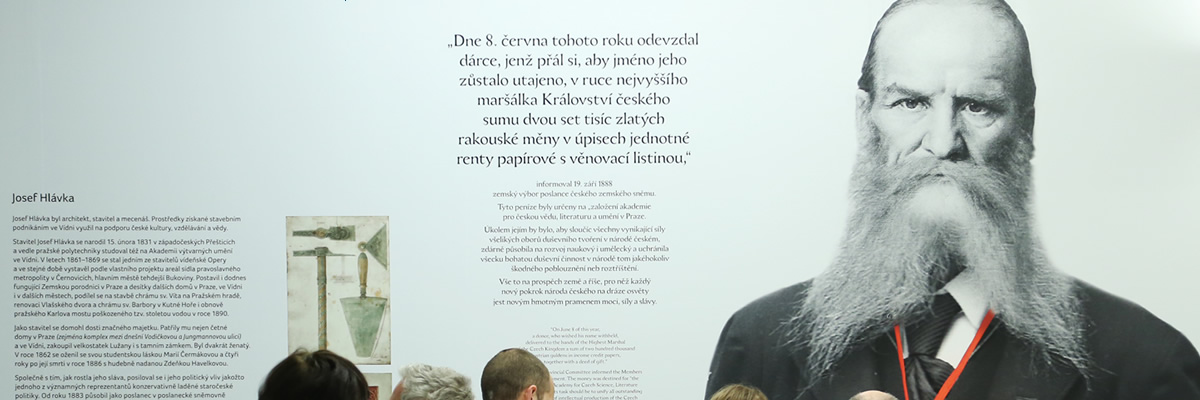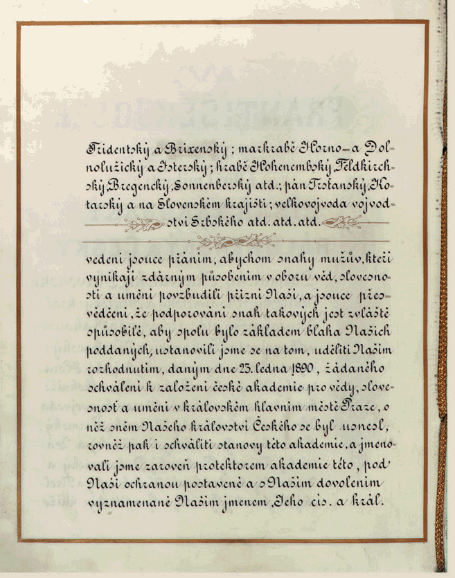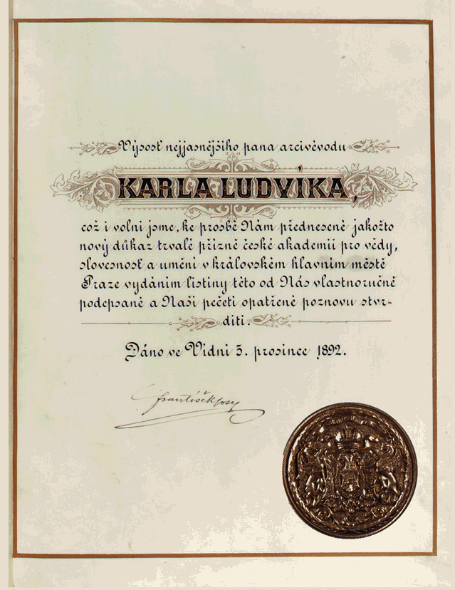
History Overview
The oldest long-lasting learned society was the Royal Czech Society of Sciences (1784–1952) which encompassed both the humanities and the natural sciences. Among its founders were philologist Josef Dobrovský, historian Gelasius Dobner, and mathematician and founder of Prague University Observatory, Joseph Stepling; later it was headed by historian František Palacký. As early as 1861–1863 Jan Evangelista Purkyně proposed in his treatise Academia the establishment of an autonomous non-university scientific institution that would associate research institutes representing the main fields of the sciences of that time. This idea of an institution engaged in interdisciplinary research corresponds with the concept and structure of the present Czech Academy of Sciences.
The earliest predecessor of today’s Czech Academy of Sciences was the Royal Czech Society of Sciences, which was founded at the turn of the 1860s and 1870s (the name as it stands was used from 1784). However, throughout the nineteenth century, it maintained a bilingual character (with both German and Czech in use). Patriotic Czech circles therefore strived to establish a purely Czech-language academy, which they eventually achieved 125 years ago due to politically favourable circumstances. The actual negotiations were initiated by the contractor Josef Hlávka (1831–1908), who anonymously pledged to donate 200,000 Austro-Hungarian guldens to the future academy.
The establishment of the Emperor Franz Joseph Czech Academy for Sciences, Literature and Arts was approved by the Bohemian Diet on 9 October 1888, its resolution not coming into force until the establishment of the academy was authorised and its statutes approved by Emperor Franz Joseph I, which occurred on 23 January 1890. It is this date which should therefore be considered as the date of the founding of the Academy (the founding charter, signed by the Emperor on 5 December 1892, was a mere, though necessary, formality). The institution, located in the newly built building of the National Museum at the top of Wenceslas Square, commenced its activities on 18 May 1891. It was divided into four departments: 1) philosophy, social sciences, and history, 2) natural sciences, 3) philology, 4) fine arts, music, and literature. Josef Hlávka became the first chairman of the Academy (1890–1908), linking it in assets and focus with the Josef, Maria, and Zdeněk Hlávka Foundation (in short, the Hlávka Foundation, founded in 1904).
After the foundation of the independent Czechoslovak Republic in 1918 other scientific institutions were established, such as the Masaryk Academy of Labour and autonomous state institutes, such as the Slavonic, Oriental and Archaelogical Institutes. Robust international relationships of Czech research institutions culminated in their affiliation with the International Union of Academies and the International Research Council.
The Academy underwent significant changes after the establishment of the Czechoslovak Republic. On 10 November 1918, it was renamed the Czech Academy of Sciences and Arts. In 1923, the possibility of full membership was opened up for women (the first elected woman was Czech writer Eliška Krásnohorská in 1924). In 1928, the natural sciences department was divided into five sections (mathematics–physics; chemistry–mineralogy–geology; biology; medicine; technical fields). The Czech Academy of Sciences and Arts was a selective learned society whose role consisted in the representation of Czechoslovak science at home and abroad. It engaged in putting out publications and redistributing research scholarships and grants from both state funds and private foundations and funds. Expert research was centred in specialised committees, although the seeds of future institutes gradually began to take root here (including the Bureau for the Dictionary of the Czech Language, founded in 1911).
Alongside the Czech Academy of Sciences and Arts, the Royal Czech Society of Sciences, which was already becoming Bohemianized, the Masaryk Academy of Labour (founded in 1920 to organise technical labour operations in Czechoslovakia), and the Czechoslovak National Research Council (founded in 1924 to represent Czechoslovak science in international scientific institutions) all played an important role in the period of 1918–1945.
In 1945, Zdeněk Nejedlý became the last president of the Czech Academy of Sciences and Arts (1945–1952). A number of its specialised departments began to transform into scientific institutes (the Czech Language Institute was founded in 1946, the Nuclear Physics Institute in 1946–1950, the Mathematical Research Institute in 1947, the Institute for Czech Literature in 1947–1948). An additional seven so-called central research institutes (centred on biology, chemistry, physics, geology, mathematics, astronomy, and polarography) were gradually built up as part of the so-called Scientific Research Centre, founded in 1949. In 1952, both entities (together with the research facilities of the institutions listed in the preceding paragraph) were then integrated into the newly founded Czechoslovak Academy of Sciences, under which the research facilities, up until that point falling under the Ministry of Education, Sciences and Arts, were transferred – such as the State Institute of Archaeology (founded in 1919), the State Historical Institute of Publishing (1921), the Oriental Institute and the Institute of Slavonic Studies (both 1922), and others. The Slovak Academy of Sciences with its research institutes was an autonomous part of the overarching institute.
Despite having been subjected to heavy ideological pressure until the fall of the Communist regime in 1989, Czech science was nevertheless able to maintain its creative energy in a number of instances and find its way to the world scientific community (although there were disparities with the various fields of sciences at different periods of the regime). This fact was made evident, for instance, by the awarding of the Nobel Prize to Jaroslav Heyrovský in 1959 and by the worldwide recognition attained by Otto Wichterle for his discovery of contact lenses. Otto Wichterle became the first President of the Academy after the revival of democracy in Czechoslovakia. Among other outstanding representatives of Czech science who worked at the Academy in the past are mathematician Eduard Čech, theoretical physicist Václav Votruba, geophysicist Vít Kárník, physiologist Vilém Laufberger, and philosopher and co-author of Charter 77 Jan Patočka, to name but a few.
Compared to universities, which were completely sovietised by the Higher Education Act of 18 May 1950, the scientific community at the Czechoslovak Academy of Sciences retained – at least formally – a greater degree of decision-making autonomy, and thus could provide asylum even to researchers expelled from universities for ideological reasons (e.g., the literary scientist Václav Černý or the philosopher Jan Patočka, and in 1958 Otto Wichterle). As elsewhere in society at that time, however, decision-making mechanisms were fully under the control of the totalitarian regime. The period of normalisation was particularly hard on the Czechoslovak Academy of Sciences, as the then leadership of the Communist Party of Czechoslovakia took revenge for the leading role played by groups from the Academy’s social sciences institutes in the reform efforts of the Prague Spring (1968). One of the main authors of the famous political manifesto “Two Thousand Words” from June 1968, the inventor of contact lenses, Otto Wichterle, became the last chairman of the Czechoslovak Academy of Sciences after the fall of the Communist regime (1990–1992) and, during his chairmanship, the purposeful reconstruction of the research organisation as a whole was initiated.
The Czechoslovak Academy of Sciences ceased to exist on 31 December 1992 and on the same date the Czech Academy of Sciences was established, which today claims not only the scientific legacy of the Czechoslovak Academy of Sciences, but of its earlier predecessors as well.



